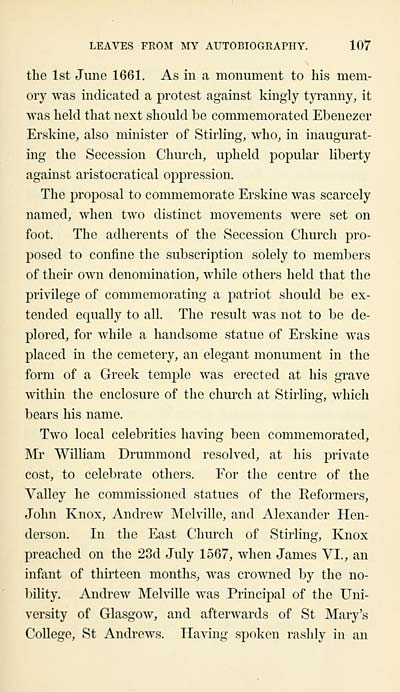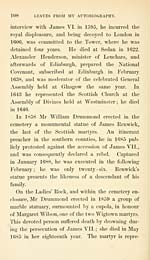Grampian Club > Leaves from my autography
(123) Page 107
Download files
Complete book:
Individual page:
Thumbnail gallery: Grid view | List view

LEAVES FROM MY AUTOBIOGRAPHY. 107
the 1st June 1661. As in a monument to his mem-
ory was indicated a protest against kingly tyranny, it
was held that next should be commemorated Ebenezer
Erskine, also minister of Stirling, who, in inaugurat-
ing the Secession Church, upheld popular liberty
against aristocratical oppression.
The proposal to commemorate Erskine was scarcely
named, when two distinct movements were set on
foot. The adherents of the Secession Church pro-
posed to confine the subscription solely to members
of their own denomination, while others held that the
privilege of commemorating a patriot should be ex-
tended equally to all. The result was not to be de-
plored, for while a handsome statue of Erskine was
placed in the cemetery, an elegant monument in the
form of a Greek temple was erected at his grave
within the enclosure of the church at Stirling, which
bears his name.
Two local celebrities having been commemorated,
Mr William Drummond resolved, at his private
cost, to celebrate others. For the centre of the
Valley he commissioned statues of the Reformers,
John Knox, Andrew Melville, and Alexander Hen-
derson. In the East Church of Stirling, Knox
preached on the 23d July 1567, when James VI., an
infant of thirteen months, was crowned by the no-
bility. Andrew Melville was Principal of the Uni-
versity of Glasgow, and afterwards of St Mary's
College, St Andrews. Having spoken rashly in an
the 1st June 1661. As in a monument to his mem-
ory was indicated a protest against kingly tyranny, it
was held that next should be commemorated Ebenezer
Erskine, also minister of Stirling, who, in inaugurat-
ing the Secession Church, upheld popular liberty
against aristocratical oppression.
The proposal to commemorate Erskine was scarcely
named, when two distinct movements were set on
foot. The adherents of the Secession Church pro-
posed to confine the subscription solely to members
of their own denomination, while others held that the
privilege of commemorating a patriot should be ex-
tended equally to all. The result was not to be de-
plored, for while a handsome statue of Erskine was
placed in the cemetery, an elegant monument in the
form of a Greek temple was erected at his grave
within the enclosure of the church at Stirling, which
bears his name.
Two local celebrities having been commemorated,
Mr William Drummond resolved, at his private
cost, to celebrate others. For the centre of the
Valley he commissioned statues of the Reformers,
John Knox, Andrew Melville, and Alexander Hen-
derson. In the East Church of Stirling, Knox
preached on the 23d July 1567, when James VI., an
infant of thirteen months, was crowned by the no-
bility. Andrew Melville was Principal of the Uni-
versity of Glasgow, and afterwards of St Mary's
College, St Andrews. Having spoken rashly in an
Set display mode to: Large image | Transcription
Images and transcriptions on this page, including medium image downloads, may be used under the Creative Commons Attribution 4.0 International Licence unless otherwise stated. ![]()
| Publications by Scottish clubs > Grampian Club > Leaves from my autography > (123) Page 107 |
|---|
| Permanent URL | https://digital.nls.uk/80084732 |
|---|
| Description | Note: Numbers 24-41 are relative to but not part of the Club's series. |
|---|---|

